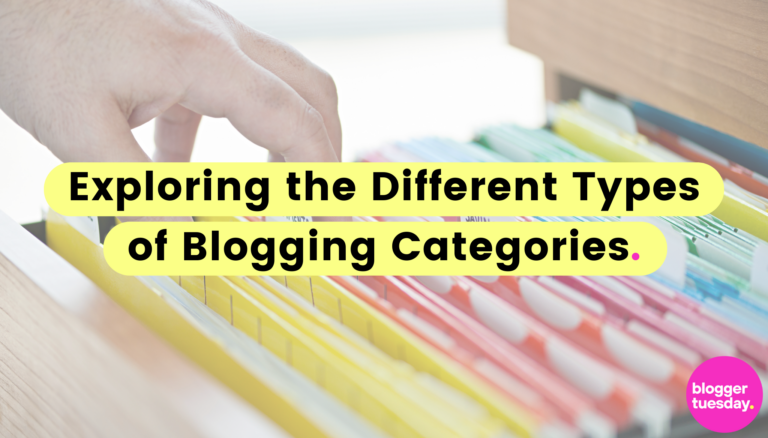There are more than 600 million blogs on the Internet. According to statistics, over 75% of web users read blogs (source). Blogging is a popular hobby, but it can also be a lucrative side hustle or a full or part-time job. If you’re a keen blogger, or you’re thinking about delving into the world of blogging, it’s important to think about the categories and subjects you want to cover.
In this guide, we’ll explore the different types of blogging categories, discussing popular topics and new trends and sharing tips to help you find your niche or conjure up new ideas for your next post.
Popular blogging categories
There are blogs to suit all tastes and interests out there, but some categories are more popular than others. Here are some of the most common blogging categories:
- Food
Data suggests that food blogs are the most common type of blog in 2023 (source). Food bloggers celebrate and indulge our collective love of eating, dining out, cooking, baking and entertaining, providing posts that focus on everything from healthy eating and nutrition to themed dishes for special occasions. Many food bloggers like to combine recipes and ideas for meals and celebrations with articles that have a lifestyle element. However, some are exclusively devoted to recipes, restaurant reviews or guides to dining out in a specific area, city, state or country.
The beauty of a food blog is that it interests almost everyone. We all need to eat to survive and in recent years, particularly during the pandemic, we’ve been cooking at home more and adopting hobbies like baking. For bloggers, there’s an opportunity to share recipes and ideas and interact with fellow foodies to establish communities and benefit from recommendations and new recipe inspiration.
If you’re thinking about launching a food blog, you may also be interested to learn that this is one of the most lucrative types of sites. Most food bloggers generate an income through ads and sponsored posts.
If you have an interest in food, think about the angle you want to take and whether you want to celebrate food in general or focus on a specific niche, for example, cooking for kids, gluten-free diets or catering for dinner parties.
- Health and fitness
Health and fitness blogs have become more popular in the last decade. More people are using devices like activity trackers to get in shape, and the pandemic inspired an increase in home cooking, online searches for healthy recipes and changes in eating habits (source). Health and fitness blogs provide a useful resource for readers who already have an interest in healthy living, as well as those who are looking to embrace lifestyle changes to boost their mental and physical health.
Blogs that specialise in exercise, working out and eating a healthy, balanced diet have been popular for years, but in recent years, there has been an increase in online content devoted to mental health, wellness, well-being and self-care. Blogs provide accessible information about mental health and they can also encourage people to be more open about their own experiences and break down barriers.
Health blogs cater to a wide range of people and they vary in terms of the subjects they cover and their target demographic. Some provide general information about healthy lifestyles while others cover categories such as:
- Specific conditions or disorders
- Health advice for children and parents, young adults, seniors and those with specific health issues or needs
- Fitness and training
- Exercise advice and inspiration
- Wellness tips
- Nutrition and improving your diet
- Weight loss and management
- Changing lifestyle habits, such as giving up smoking or drinking
- Travel
Studies show that more than 80% of people use the Internet for planning trips and a third of users read travel blogs to get advice and inspiration (source). Travel blogs provide access to articles, guides and features that cater to everyone from intrepid adventurers and experienced globetrotters to people planning their first city break or romantic getaway with a partner. Most people love to travel. Reading posts is an opportunity to:
- Learn about different destinations
- Get advice from seasoned travellers
- Access checklists and guides
- Find out more about attractions, excursions, tours, hotels and things to see and do
If you enjoy travelling, setting up a travel blog provides the perfect excuse to explore more of the world and potentially turn your interest into an income stream. Travel bloggers usually earn money by writing posts about places they are paid to visit or recommending specific hotels or restaurants, for example. They may also earn commission through advertising travel products or services.
Travel blogs have a broad spectrum of readers, and they cater to all age groups. Some have a narrow focus, for example, family holidays and days out with kids, bucket-list destinations or advice for saving money and reducing stress when planning trips. Others cover a much wider range of categories, from destination guides and everyday travel tips to planning experiences or active adventures.
- Fashion and beauty
Fashion and beauty blogs target readers who are interested in the latest catwalk trends and beauty and skincare products. Most target women aged between 18 and 50 but there has been an increase in the number of sites that talk about male fashion and beauty trends.
One of the best things about launching a blog about fashion and beauty if you’re passionate about these categories is that there is never a shortage of themes to discuss. New trends emerge every season and the world of fashion has become more diverse and accessible. Fashion blogs cover an array of topics from the latest summer looks and must-have beauty products to sustainable fashion, savvy tips to save money on wardrobe updates and advice for dressing for special occasions or choosing practical but stylish workwear.
- Business
A 2020 UK survey suggests that more than 60% of employees want to set up their own business (source). Interest in entrepreneurship is growing. To reflect this trend and rising rates of self-employment and freelancing, the number of business blogs is increasing. Many sites that include multiple categories, such as lifestyle, health and fitness, work and careers, parenting and financial advice, also feature business advice.
There are two main types of business blogs. The first is professional blogs that cater to entrepreneurs or people who are in the process of launching a start-up. Articles tend to be more detailed and complex and focus on business advice, marketing and sales and practical strategies that optimise results. There may also be sections for news and industry-specific posts. The second is a more general blog, which shares accessible, digestible content, such as guides to setting up a home-based business or marketing tips for beginners.
- Lifestyle
Lifestyle is one of the most popular blogging categories. This is a broad category, which can cover all kinds of topics and cater to everyone from parents and students to retirees, seniors and young adults. Topics can range from living the high life in a bustling big city to embracing the peace of country living. Examples of subcategories you may find on a lifestyle blog include:
- DIY, remodelling and renovations
- Home improvement and maintenance
- Crafting
- Style
- Travel and exploring the local area
- Hobbies
- Personal life lessons, tips and advice
- Food and healthy living
- Parenting
Parenting blogs tackle arguably the most important but challenging job on the planet: raising children. In the past decade, parenting blogs have become increasingly popular. In 2015, over 80% of mums read at least 5 blog articles per week. As the traditional role of the father figure has evolved and blogs have become an increasingly integral source of information and advice, Dad blogs have become popular, as well as the hugely successful and well-known Mom blogs, which took off between 2010 and 2015.
Parenting blogs can be sites to access general advice or tips, or they can cover niche subjects, such as dealing with challenging behaviour or preparing for life as a new parent. Articles may include guides and tutorials, recommendations and advice, personal stories and product reviews.
How to choose categories for your blog
If you are new to blogging and you’re thinking about creating a blog, or you’re considering adding new categories to an existing, established site, here are some tips to help you choose categories for your blog:
- Focus on your interests, hobbies and passions
- Consider your target reader
- Look for categories that complement the themes and topics you already cover
- Gauge audience reactions and responses and encourage readers to share ideas and feedback
- Take inspiration from new trends
- Write about categories that you know about
Summary
There are over 600 million blogs in the world, which cover a vast array of categories. From business, parenting, travel and lifestyle to fashion, DIY, arts and crafts and sports and leisure, there’s a blog for every reader.
If you’re thinking about becoming a blogger, or you’re looking for ideas to expand your category list, it’s beneficial to consider popular and trending categories and topics and focus on areas that interest you. Once you have chosen a category, you can decide whether to adopt a general approach or concentrate on niche subjects.


